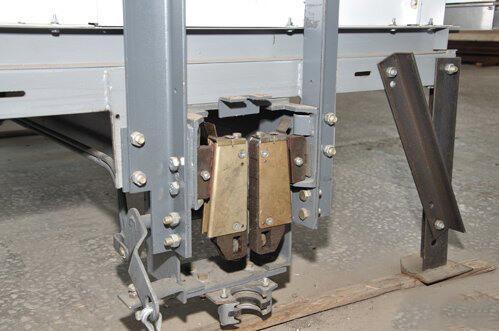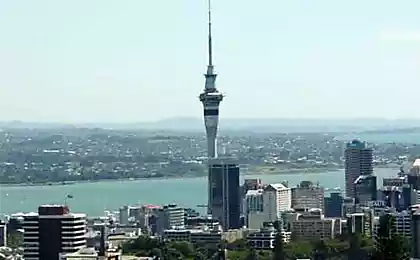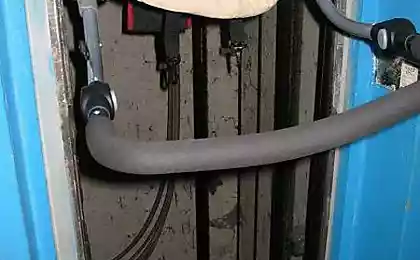659
How to survive in a falling Elevator?
Read today about another tragedy, Elevator in Penza fell with the woman and child. Recently fell in Moscow, the lift with the child, then with a known host, then somewhere else. Over the last six months times four or five (from what I heard in the media) were falling Elevator. Already and very soon would be scared to ride the elevators.
I don't understand how this could be. After a lot of time ago there was invented a reliable MECHANICAL Elevator brake. All the elevators except as approved by the various electronic brakes, limiters and automation, mechanical and is the simplest system.
Here's how it works ...
The catcher Otis was a flat spring (leaf spring) mounted on the roof of the Elevator. The tension of the cable twisting the spring and the Elevator quietly went up or down. In the event of breakage of rope the spring was straightened and rested the ends of the rails, blocking the Elevator.

Elevator brake: yesterday and today
Yesterday: in the normal position the spring is stretched (1), in the event of breakage of ropes, it becomes a strut and brakes the Elevator (2).
Today: in the normal position the cable separator is rigidly connected with the cabin (3) when you fall the rope is blocked and pulls the wedge Shoe hold (4)
The safety of the passengers the usual modern lifts provide about 30 electronic and 5 mechanical devices. The most important are the automatic catcher. They are still mechanical, although arranged differently than the original invention of the Otis. Modern catchers are controlled by a separate belt and pulley of the speed limiter.
If you exceed the vertical speed of the Elevator centrifugal speed limiter stops the pulley and, respectively, the cable, rigidly connected with the cabin, too, stops. Upon further movement (including the fall) the Elevator stopped the rope speed limiter "pulls" the wedge shoes of the catcher mounted on the cab, slowing down the Elevator to a complete stop. It is similar to the principle of automobile seat belts.
Control of the retarder via a separate cable allows you not only to stop the Elevator in case of breakage of the traction rope, but also when failure of the engine control system due to, for example, overload.

In addition, the cabin is catching — like the iron pins of the device, which in the case of the need to drastically clamp the rope, stopping the movement of the cab. So even if all three of the cable terminates immediately, the Elevator will not fall and just stop in the mine.
Here's how you can "screw up" with the maintenance or Assembly of the lift, so he fell down, and none of the defense mechanisms wouldn't work? I can understand the tragedy, when the fault of electronics is not the time the cabin begins to move or doors open when cab is not. But all I listed in the beginning of the post, cases the cabin just fell into the Elevator shaft. How?
It was supposed to be like this:
In 2012, the accident with the Elevator in Petersburg. In a house located on Mountain street in the district of Sochi, the cabin collapsed from the fifth floor. Inside were passengers — two men. Fortunately, the system worked security, and all survived.
In 2013 there was a case in the Moscow business center snapped the Elevator. Almost half an hour spent in the Elevator seven employees at the business centre before they were released from the steel bondage. In the fall of the Elevator from the 17th to the 14th floor of one of the passengers suffered a broken leg, and two less serious injuries.
The victims themselves believe that they got off easy: if not triggered the emergency brake inside the Elevator people could die.
Despite the tragedy, employees of the business center, stuck on the 14th floor, I was very optimistic and filming everything on camera phones.
But the regular brakes work!
Let's say you were in a freely falling Elevator cabin.
What should I do ?
If you believe the makers of Hollywood blockbusters, the proper course in such cases is to jump just before hitting the ground up to reduce the speed of his body.
But even if you have a fantastic response and won an Olympic medal for the high jump, the maximum that can be achieved with this method, the falling speed will decrease by 3-5 km/h. most Likely, people jumped hit my head on the cabin ceiling, and then landed badly, seriously hurt.
Others offer to stand with bent knees, which should take the brunt of the impact force − so do paratroopers upon landing.
Theoretically, as soon as the Elevator reaches the ground, your legs will automatically bend and body movement will slow down somewhat. However, at high speeds, this technique is unlikely to be effective.
Experiments show that with this approach, your knees and legs will take the brunt of the impact force, resulting in a fracture.
What should I do?
The researchers came to the conclusion that to maximize its chances to survive in a free falling Elevator, you should lie on your back on the floor and protect your face with your hands from falling debris.
In this case, the force of impact more or less distributed throughout the body, and the spine and large bones will be located parallel to the direction of impact and, therefore, is unlikely to break. Ribs still face a significant risk with which to be reckoned.
However, even in this scenario the following problems occur:
1. The main impact from the floor of the cabin will assume the soft tissues, particularly the brain. Imagine a collision with a car at a speed of 70 km/h and you will see what injuries have to deal with.
2. There is a high probability that when you drop the car split open, and the floor on which you lie, it will turn into a pile of sharp pieces.
You may recall, for example, about Betty Lou Oliver, who survived the fall of the Elevator in the Empire state building in 1945. This achievement, by the way, noted in the Guinness Book of records. She followed our advice, sharp pieces of a broken Elevator cabin surely pierced her through and through. Life she owes modem cable at the base of the Elevator shaft, magciusis fall. If she lay down on the floor, it almost certainly would have died.
3. Be aware that you are in a free fall not only relative to the Elevator shaft, but falling against the cab, i.e. in a matter of seconds are in a state of weightlessness.
In this state, to manage to lie down on the floor and somehow keep it very difficult, especially for untrained persons.

But even given these factors it is argued that the best chances of survival will be those who will still be able to lie down on his back. Also the probability to threat of injury greatly reduced.published
See also: Why NOT take pictures of sleeping people
Why is there a sense of deja vu
P. S. And remember, only by changing their consumption — together we change the world! ©
Join us in Facebook , Vkontakte, Odnoklassniki
Source: masterok.livejournal.com/2871634.html
I don't understand how this could be. After a lot of time ago there was invented a reliable MECHANICAL Elevator brake. All the elevators except as approved by the various electronic brakes, limiters and automation, mechanical and is the simplest system.
Here's how it works ...
The catcher Otis was a flat spring (leaf spring) mounted on the roof of the Elevator. The tension of the cable twisting the spring and the Elevator quietly went up or down. In the event of breakage of rope the spring was straightened and rested the ends of the rails, blocking the Elevator.

Elevator brake: yesterday and today
Yesterday: in the normal position the spring is stretched (1), in the event of breakage of ropes, it becomes a strut and brakes the Elevator (2).
Today: in the normal position the cable separator is rigidly connected with the cabin (3) when you fall the rope is blocked and pulls the wedge Shoe hold (4)
The safety of the passengers the usual modern lifts provide about 30 electronic and 5 mechanical devices. The most important are the automatic catcher. They are still mechanical, although arranged differently than the original invention of the Otis. Modern catchers are controlled by a separate belt and pulley of the speed limiter.
If you exceed the vertical speed of the Elevator centrifugal speed limiter stops the pulley and, respectively, the cable, rigidly connected with the cabin, too, stops. Upon further movement (including the fall) the Elevator stopped the rope speed limiter "pulls" the wedge shoes of the catcher mounted on the cab, slowing down the Elevator to a complete stop. It is similar to the principle of automobile seat belts.
Control of the retarder via a separate cable allows you not only to stop the Elevator in case of breakage of the traction rope, but also when failure of the engine control system due to, for example, overload.

In addition, the cabin is catching — like the iron pins of the device, which in the case of the need to drastically clamp the rope, stopping the movement of the cab. So even if all three of the cable terminates immediately, the Elevator will not fall and just stop in the mine.
Here's how you can "screw up" with the maintenance or Assembly of the lift, so he fell down, and none of the defense mechanisms wouldn't work? I can understand the tragedy, when the fault of electronics is not the time the cabin begins to move or doors open when cab is not. But all I listed in the beginning of the post, cases the cabin just fell into the Elevator shaft. How?
It was supposed to be like this:
In 2012, the accident with the Elevator in Petersburg. In a house located on Mountain street in the district of Sochi, the cabin collapsed from the fifth floor. Inside were passengers — two men. Fortunately, the system worked security, and all survived.
In 2013 there was a case in the Moscow business center snapped the Elevator. Almost half an hour spent in the Elevator seven employees at the business centre before they were released from the steel bondage. In the fall of the Elevator from the 17th to the 14th floor of one of the passengers suffered a broken leg, and two less serious injuries.
The victims themselves believe that they got off easy: if not triggered the emergency brake inside the Elevator people could die.
Despite the tragedy, employees of the business center, stuck on the 14th floor, I was very optimistic and filming everything on camera phones.
But the regular brakes work!
Let's say you were in a freely falling Elevator cabin.
What should I do ?
If you believe the makers of Hollywood blockbusters, the proper course in such cases is to jump just before hitting the ground up to reduce the speed of his body.
But even if you have a fantastic response and won an Olympic medal for the high jump, the maximum that can be achieved with this method, the falling speed will decrease by 3-5 km/h. most Likely, people jumped hit my head on the cabin ceiling, and then landed badly, seriously hurt.
Others offer to stand with bent knees, which should take the brunt of the impact force − so do paratroopers upon landing.
Theoretically, as soon as the Elevator reaches the ground, your legs will automatically bend and body movement will slow down somewhat. However, at high speeds, this technique is unlikely to be effective.
Experiments show that with this approach, your knees and legs will take the brunt of the impact force, resulting in a fracture.
What should I do?
The researchers came to the conclusion that to maximize its chances to survive in a free falling Elevator, you should lie on your back on the floor and protect your face with your hands from falling debris.
In this case, the force of impact more or less distributed throughout the body, and the spine and large bones will be located parallel to the direction of impact and, therefore, is unlikely to break. Ribs still face a significant risk with which to be reckoned.
However, even in this scenario the following problems occur:
1. The main impact from the floor of the cabin will assume the soft tissues, particularly the brain. Imagine a collision with a car at a speed of 70 km/h and you will see what injuries have to deal with.
2. There is a high probability that when you drop the car split open, and the floor on which you lie, it will turn into a pile of sharp pieces.
You may recall, for example, about Betty Lou Oliver, who survived the fall of the Elevator in the Empire state building in 1945. This achievement, by the way, noted in the Guinness Book of records. She followed our advice, sharp pieces of a broken Elevator cabin surely pierced her through and through. Life she owes modem cable at the base of the Elevator shaft, magciusis fall. If she lay down on the floor, it almost certainly would have died.
3. Be aware that you are in a free fall not only relative to the Elevator shaft, but falling against the cab, i.e. in a matter of seconds are in a state of weightlessness.
In this state, to manage to lie down on the floor and somehow keep it very difficult, especially for untrained persons.

But even given these factors it is argued that the best chances of survival will be those who will still be able to lie down on his back. Also the probability to threat of injury greatly reduced.published
See also: Why NOT take pictures of sleeping people
Why is there a sense of deja vu
P. S. And remember, only by changing their consumption — together we change the world! ©
Join us in Facebook , Vkontakte, Odnoklassniki
Source: masterok.livejournal.com/2871634.html
Frame pool on the site: how to cook pad under pool
Use this remedy—pimples and acne more you get back!























